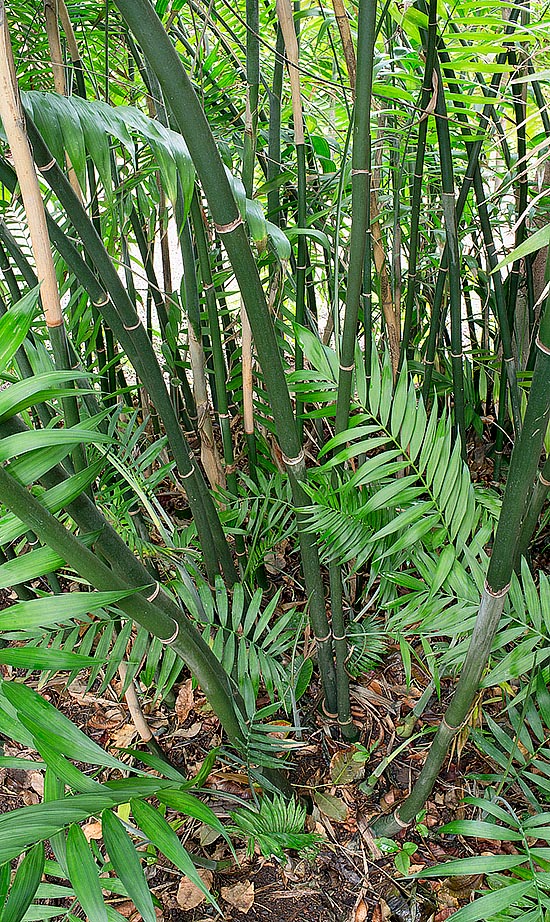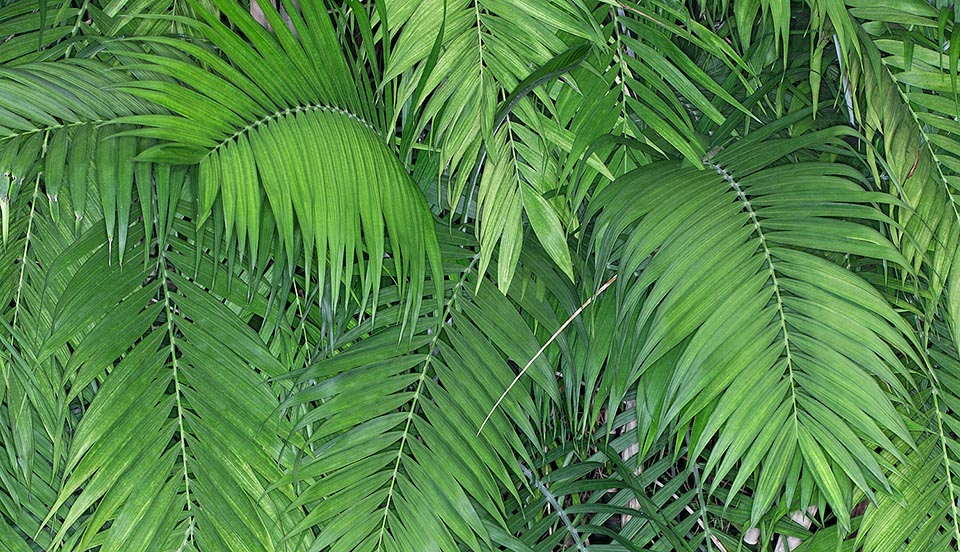Family : Arecaceae

Text © Pietro Puccio

English translation by Mario Beltramini

In western Mexico the Chamaedorea pochutlens forms dense 2-5 m tall tufts © Giuseppe Mazza
The name of the genus is the combination of the Greek adverb “χαμαί” (chamai) = on the ground, on the soil, and of the substantive “δωρέα” (doréa) = gift, the German botanist Carl Ludwig Willdenow (1765-1812), who created the genus in 1806, did not specify the exact meaning of the name. The Latin specific name “pochutlensis” = of Pochutla, refers to the site in the state of Oaxaca where it has been discovered.
Common names: cannelilla palm (English); canelilla (Mexico).
The Chamaedorea pochutlensis Liebm. (1849) is a dioecious species forming quickly dense tufts with erect or slightly inclined stems, of 2-5 m of length and of 2-2,5 cm of diameter, of intense green colour and on which are visible the whitish rings of the foliar scars spaced of 6-25 cm.
The leaves, on a 15-30 cm long petiole, are pinnate, 1-1,6 m long, with 15-30 alternate or sub-opposite leaflets regularly arranged on both sides of the rachis, lanceolate with pointed apex, 15-35 cm long and 1,5-3 cm broad, of intense green colour. The tubular foliar base, open obliquely at the apex, of pale green colour and initially covered, like the petiole, by a thin pale blue waxy patina, wraps entirely the stem for a length of 20-30 cm.
Inflorescences, on a 25-35 cm long peduncle, under the leaves (infrafoliar), erect, ramified, the male ones with green flowers, of about 4 mm of diameter, drawn near and arranged spirally, the female ones with yellow flowers, of about 4 mm of diameter, spaced and arranged spirally on the rachils initially of green colour, then reddish orange when in fruit.
Globose to ellipsoid fruits, 1,2-1,5 cm long and of 0,8-1 cm of diameter, black when ripe and covered by a bluish waxy patina.
It reproduces by seed, in draining loam maintained humid at the temperature of 24-26 °C, with germination times fairly variable starting from 3-4 weeks, and by division.
Very ornamental and fast growing species, but relatively little diffused, similar to the Chamaedorea costaricana Oerst., with which is often mistaken, but easily distinguishable due to the presence of the ligula at the apex of the foliar sheath, absent in the Chamaedorea pochutlensis. Cultivable in parks and gardens of the tropical subtropical and marginally temperate-warm regions, where it can stand temperatures up to -4 °C, if exceptional and short lasting, in mass or for realizing elegant hedgerows.

Very ornamental species and fast growing with good resistance to cold but relatively little diffused. In suitable pots it might embellish large luminous indoor spaces © Giuseppe Mazza
Synonyms: Chamaedorea karwinskyana H.Wendl. (1853); Nunnezharia karwinskyana (H.Wendl.) Kuntze (1891); Nunnezharia pochutlensis (Liebm.) Kuntze (1891).
→ For general notions about ARECACEAE please click here.
